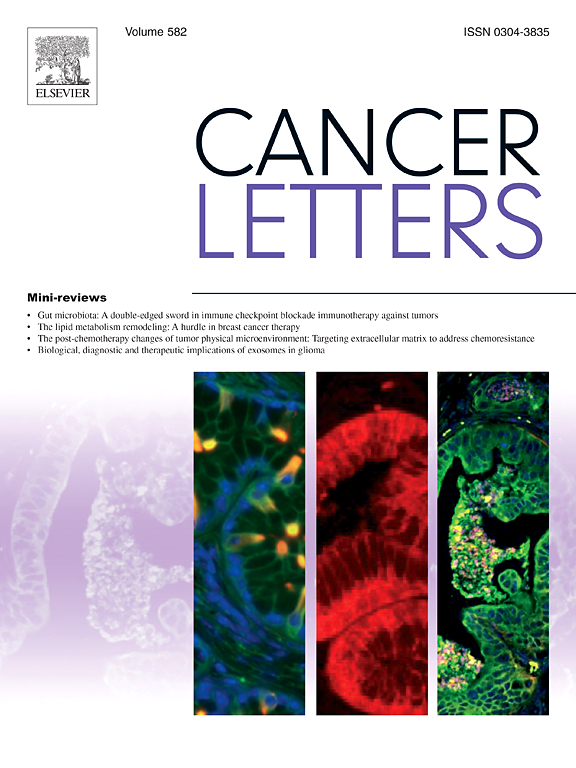靶向肌苷代谢增强egfr在肺腺癌中的靶向治疗。
IF 10.1
1区 医学
Q1 ONCOLOGY
引用次数: 0
摘要
虽然表皮生长因子受体(EGFR)酪氨酸激酶抑制剂(TKIs)对治疗EGFR突变型肺腺癌(LUAD)有效,但耐药性显著削弱了其治疗效果。在这项研究中,我们探索了与EGFR-TKI耐药相关的代谢特征,并发现核苷肌苷在tki耐药细胞、耐药持久性(DTP)细胞和临床tki残留肿瘤中显著积累。机械上,积累的肌苷激活了腺苷A2A受体(A2aR)和cAMP-PKA-CREB信号通路,从而增强氧化磷酸化和TKI抗性。此外,我们发现tki耐药细胞分泌的肌苷也诱导巨噬细胞的m2样重编程。嘌呤核苷酸磷酸化酶(PNP)下调被认为是肌苷积累的关键因素。PNP在tki耐药细胞中的过度表达不仅增加了tki耐药细胞对EGFR-TKIs的敏感性,而且通过提高毒性黄嘌呤、尿酸和ROS的产生诱导细胞死亡。此外,PNP过表达或使用taminadenant(一种用于临床试验的a2ar靶向抑制剂)可显著增强体外、患者源性类器官、细胞源性异种移植物和携带人类egfr驱动的自发性肺肿瘤的小鼠模型中egfr靶向治疗反应。总的来说,我们的研究结果阐明了肌苷代谢在TKI耐药中的作用,强调了一种潜在的治疗策略-靶向肌苷/A2aR轴-在LUAD治疗中抵消EGFR-TKI耐受性。本文章由计算机程序翻译,如有差异,请以英文原文为准。
Targeting inosine metabolism to enhance EGFR-targeted therapy in lung adenocarcinoma
Although epidermal growth factor receptor (EGFR) tyrosine kinase inhibitors (TKIs) are effective for treating EGFR-mutant lung adenocarcinoma (LUAD), resistance significantly impairs their therapeutic effect. In this study, we explored the metabolic features associated with EGFR-TKI resistance and identified the nucleoside inosine as being significantly accumulated in TKI-resistant cells, drug-tolerant persister (DTP) cells, and clinical TKI-residual tumors. Mechanically, accumulated inosine activated the adenosine A2A receptor (A2aR) and the cAMP-PKA-CREB signaling pathway, thereby enhancing oxidative phosphorylation and TKI resistance. Additionally, we identified that inosine secreted by TKI-resistant cells also induced M2-like reprogramming of macrophages. Downregulated purine nucleotide phosphorylase (PNP) was identified as the pivotal factor for the accumulation of inosine. Overexpression of PNP in TKI-resistant cells not only increased sensitivity of TKI-resistant cells to EGFR-TKIs, but also induced cell death by elevating toxic xanthine, uric acid, and ROS production. Furthermore, overexpression of PNP or using taminadenant, a A2aR-targeting inhibitor used in clinical trials, significantly enhances the EGFR-targeted therapeutic response in vitro, as well as in patient-derived organoids, cell-derived xenografts and mouse models bearing human EGFR-driven spontaneous lung tumor. Overall, our findings clarify the role of inosine metabolism in TKI resistance, highlighting a potential therapeutic strategy—targeting the inosine/A2aR axis—to counteract EGFR-TKI tolerance in LUAD treatment.
求助全文
通过发布文献求助,成功后即可免费获取论文全文。
去求助
来源期刊

Cancer letters
医学-肿瘤学
CiteScore
17.70
自引率
2.10%
发文量
427
审稿时长
15 days
期刊介绍:
Cancer Letters is a reputable international journal that serves as a platform for significant and original contributions in cancer research. The journal welcomes both full-length articles and Mini Reviews in the wide-ranging field of basic and translational oncology. Furthermore, it frequently presents Special Issues that shed light on current and topical areas in cancer research.
Cancer Letters is highly interested in various fundamental aspects that can cater to a diverse readership. These areas include the molecular genetics and cell biology of cancer, radiation biology, molecular pathology, hormones and cancer, viral oncology, metastasis, and chemoprevention. The journal actively focuses on experimental therapeutics, particularly the advancement of targeted therapies for personalized cancer medicine, such as metronomic chemotherapy.
By publishing groundbreaking research and promoting advancements in cancer treatments, Cancer Letters aims to actively contribute to the fight against cancer and the improvement of patient outcomes.
 求助内容:
求助内容: 应助结果提醒方式:
应助结果提醒方式:


